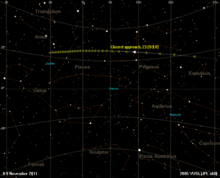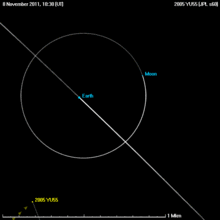(308635) 2005 YU55
|
| |
| Discovery[1] | |
|---|---|
| Discovered by |
R. S. McMillan Steward Observatory, Kitt Peak (691) |
| Discovery date | 28 December 2005 |
| Designations | |
| MPC designation | 2005 YU55 |
Apollo  NEO, PHA[2] | |
| Orbital characteristics[2] | |
| Epoch 13 January 2016 (JD 2457400.5) | |
| Uncertainty parameter 0 | |
| Observation arc | 2183 days (5.98 yr) |
| Aphelion | 1.65562913 AU (247.678593 Gm) (Q) |
| Perihelion | 0.659003712 AU (98.5855521 Gm) (q) |
| 1.15731642 AU (173.132072 Gm) (a) | |
| Eccentricity | 0.430576028 (e) |
| 1.25 yr (454.75 d) | |
| 175.227687° (M) | |
| 0° 47m 29.892s / day (n) | |
| Inclination | 0.340553512° (i) |
| 35.9073158° (Ω) | |
| 273.628156° (ω) | |
| Known satellites | none[3] |
| Earth MOID |
0.000433476 AU (64,847.1 km) (0.17 LD)[2] |
| Venus MOID |
0.0017 AU (0.66 LD)[4] |
| Mars MOID |
0.03884 AU (15.11 LD)[4] |
| Jupiter MOID | 3.60813 AU (539.769 Gm) |
| Jupiter Tisserand parameter | 5.347 |
| Physical characteristics | |
| Dimensions | 360±40 meters[5][6][7][8] |
Mean radius | 0.2 km |
| 18 h (0.75 d) | |
Sidereal rotation period | 19.31 ± 0.02 h[2][9] |
| 0.042±0.008 | |
| C-type[6][9][10] | |
| 21.9[2][9] | |
|
| |
(308635) 2005 YU55, provisionally known as 2005 YU55, is a potentially hazardous asteroid[2] 360±40 meters in diameter, as measured after its Earth flyby.[8] Previously it was estimated at 310 meters[5] or about 400 m (1,300 feet) in diameter.[6][7] It was discovered on 28 December 2005 by Robert S. McMillan at Steward Observatory, Kitt Peak.[1] On 8 November 2011 it passed 0.85 lunar distances (324,900 kilometers; 201,900 miles)[11] from Earth.
8 November 2011 flyby

In February 2010, (308635) 2005 YU55 was rated 1 on the Torino Scale for a potential pass near Earth on November 10, 2103,[12] that posed no unusual level of danger. On 19 April 2010, radar ranging by the Arecibo radio telescope reduced uncertainties about the orbit by 50%.[7] This improvement eliminated any possibility of an impact with Earth within the next 100 years.[7] It was removed from the Sentry Risk Table on 22 April 2010 and as such it now has a rating of 0 on the Torino Scale.[13] It is now known that on 10 November 2103 (308635) 2005 YU55 will be roughly 2 AU from Earth.[14]
On 8 November 2011 at 23:28 UT the asteroid passed 0.85 LD (330,000 km; 200,000 mi) from Earth.[11] On 9 November 2011 at 07:13 UT the asteroid passed 0.6231 LD (239,500 km; 148,800 mi) from the Moon.[15] During the close approach the asteroid reached about apparent magnitude 11,[6][16] and would have been visible to experienced observers using high-end binoculars with an objective lens of 80+ mm if it were not for bright moonlight preventing a true dark sky. Since the gibbous moon did interfere with the viewing,[3] observers trying to visually locate the asteroid required a telescope with an aperture of 6 inches (15 centimeters) or larger.[3][11]
The next few times a known asteroid this large will come this close to Earth will be in 2028[3] when (153814) 2001 WN5 passes 0.65 LD from Earth,[17] and in 2029 when the 325-meter 99942 Apophis comes even closer at just 0.01 LD.[18]
According to Jay Melosh, if an asteroid the size of (308635) 2005 YU55 (~400 m across) were to hit land, it would create a crater 6.3 km (3.9 mi) across, 518 m (1,699 ft) deep and generate a seven-magnitude-equivalent-earthquake.[19] The chances of an actual collision with an asteroid like (308635) 2005 YU55 is about 1 percent in the next thousand years.[19]
Study

During the 2011 passage (308635) 2005 YU55 was studied with radar using Goldstone, Arecibo, the Very Long Baseline Array, and the Green Bank Telescope.[3] The Herschel Space Observatory has made far-infrared measurements of (308635) 2005 YU55 on November 10, helping determine its temperature and composition.[20]
Radar analysis has also helped to pin down the asteroid's albedo, or diffuse reflectivity. Although radar measurements do not detect visible light they can determine the distance and size of an object with a high degree of accuracy. This information, coupled with visible light measurements, provides a more accurate measure of an object's absolute magnitude, and therefore its albedo.
On November 8, 2011, NASA released a statement mentioning a number of structures on the surface of the asteroid, which were detected as it passed near Earth.[21] On November 11, 2011, higher-resolution images showed concavities, a ridge near the asteroid's equator, and numerous features interpreted as decameter-scale boulders.[8][22] Shape modeling based on the radar images shows that YU55's shape is close to spheroidal, with maximum dimensions of 360±40 m, and an equator-aligned ridge. A 150–200-meter-long, ~20-meter-high rise forms a portion of the ridge-line, and the number of boulders on the surface is comparable to that seen on the asteroid 25143 Itokawa by the Hayabusa spacecraft.[8]
Optical lightcurve measurements during the flyby provided a more accurate estimate of the asteroid's spin period – about 19.3 hours.[9] Because (308635) 2005 YU55 is so nearly spheroidal, it was not significantly torqued by Earth's tides during the flyby, and there is no evidence of non-principal-axis rotation. Optical, near-infrared,[10] and ultraviolet[23] spectroscopy confirmed that 2005 YU55 is a C-type asteroid.
Future trajectory
On 19 January 2029, (308635) 2005 YU55 will pass 0.0023 AU (340,000 km; 210,000 mi) from Venus.[15] The close approach distance to Venus in 2029 will determine how close the asteroid will pass to Earth in 2041.[3] Before the November 2011 observations, the uncertainties in the post-2029 trajectory showed that the asteroid would pass somewhere between 0.002 AU (300,000 km; 190,000 mi) and 0.3 AU (45,000,000 km; 28,000,000 mi) of Earth in 2041.[3] Radar astrometry in November 2011 clarified the Earth passage in 2041 and beyond.[3] As a result of the November 2011 radar observations, it is now known that (308635) 2005 YU55 will pass between 0.1017 AU (15,210,000 km; 9,450,000 mi) and 0.1020 AU of Earth on 12 November 2041.[15] Using the current uncertainty region integrated until the future, the 2075 approach will be between 0.0013 AU (190,000 km; 120,000 mi) and 0.0021 AU (310,000 km; 200,000 mi).[15]
References
- 1 2 "MPEC 2005-Y47 : 2005 YU55". IAU Minor Planet Center. 2005-12-29. Retrieved 2011-05-05.
- 1 2 3 4 5 6 "JPL Small-Body Database Browser: 308635 (2005 YU55)" (last observation: 2011-12-16; arc: 5.98 years). Retrieved 7 April 2016.
- 1 2 3 4 5 6 7 8 Dr. Lance A. M. Benner (2011-10-29). "2005 YU55 Goldstone Radar Observations Planning". NASA/JPL Asteroid Radar Research. Retrieved 2011-10-30.
- 1 2 "Minor Planet Center - 2005 YU55". Minor Planet Center. Retrieved 2014-11-19.
- 1 2 The Herschel Space Observatory catches a glimpse of the minor planet during its rendezvous with Earth (November 17, 2011)
- 1 2 3 4 Don Yeomans; Lance Benner & Jon Giorgini (March 10, 2011). "Asteroid 2005 YU55 to Approach Earth on November 8, 2011". NASA/JPL Near-Earth Object Program Office. Archived from the original on 24 April 2011. Retrieved 2011-05-05.
- 1 2 3 4 Blaine Friedlander Jr. (April 30, 2010). "Arecibo telescope tracks 'potentially dangerous' asteroid within 1.5 million miles of Earth". Cornell Chronicle @ Cornell University. Archived from the original on 23 May 2011. Retrieved 2011-05-05.
- 1 2 3 4 M.W. Busch; et al. (March 31, 2012). "Shape and Spin of Near-Earth Asteroid 308635 (2005 YU55) From Radar Images and Speckle Tracking" (PDF). LPI. Retrieved 9 April 2012.
- 1 2 3 4 B.D. Warner; et al. (March 31, 2012). "CCD PHOTOMETRIC OBSERVATIONS OF 2005 YU55 DURING THE 2011 NOVEMBER FLYBY" (PDF). LPI. Retrieved 9 April 2012.
- 1 2 N.A. Moskovitz (March 31, 2012). "THE NEAR-EARTH ENCOUNTER OF 2005 YU55: TIME-RESOLVED VISIBLE AND NEAR- INFRARED SPECTROSCOPY" (PDF). LPI. Retrieved 9 April 2012.
- 1 2 3 "NASA in Final Preparations for Nov. 8 Asteroid Flyby". NASA/JPL. October 26, 2011. Retrieved 2011-10-26.
- ↑ "Earth Impact Risk Summary: 2005 YU55". Wayback Machine: NASA/JPL Near-Earth Object Program Office. 2010-03-25. Archived from the original on 2010-03-25. Retrieved 2013-10-23. (6.1e-04 = 1 in 1,640 chance)
- ↑ "Date/Time Removed". NASA/JPL Near-Earth Object Program Office. Archived from the original on 26 April 2011. Retrieved 2011-05-06.
- ↑ "(308635) 2005YU55 Ephemerides for 10 November 2103". NEODyS (Near Earth Objects – Dynamic Site). Retrieved 2013-10-23.
- 1 2 3 4 "JPL Close-Approach Data: (2005 YU55)" (last observation: 2011-12-16; arc: 5.98 years). Retrieved 2013-09-07.
- ↑ "2005YU55 Ephemerides for 9 Nov 2011". NEODyS (Near Earth Objects – Dynamic Site). Retrieved 2011-05-05.
- ↑ "JPL Close-Approach Data: 153814 (2001 WN5)" (last observation: 2011-01-04; arc: 14.9 years). Retrieved 2011-10-16.
- ↑ "NEO Earth Close-Approaches (Between 1900 A.D. and 2200 A.D., NEOs with H <=22, nominal distance within 5 LD)". Near-Earth Object Program Office. NASA/JPL. Retrieved 17 May 2015.
- 1 2 Elizabeth K. Gardner (October 31, 2011). "Large asteroid to pass by Earth Nov. 8, but what if it didn't?". Purdue University. Retrieved 2011-11-07.
- ↑ chrisnorth (6 November 2011). "Herschel to observe near-Earth asteroid". UK Outreach Site for the Herschel Space Observatory. Retrieved 2011-11-07.
- ↑ "NASA Releases Radar Movie of Asteroid 2005 YU55". NASA. November 8, 2011. Retrieved 6 December 2011.
- ↑ "NASA Releases Updated Radar Movie of Asteroid 2005 YU55 (2011–351)". NASA/JPL. 2011-11-11. Retrieved 2011-12-06.
- ↑ http://www.astro.umd.edu/~dennis/Dennis_Bodewits/YU55_CBET.html
External links
| Wikimedia Commons has media related to 2005 YU55. |
- Orbital simulation from JPL (Java) / Horizons Ephemeris
- Live Webcast: Keck Telescope To Watch Asteroid Flyby (Ustream video)
- 2005 YU55 Observing Campaign
- Close, but no Cigar: The Flyby of Asteroid 2005 YU55 (MPC blog with flyby simulated animations)
- Orbital simulation of 2005 YU55 in an animated GIF image provided by nasa.gov
- NASA Asteroid Q&A (on YU55) (November 1, 2011)
- Arecibo saves us from another potentially hazardous asteroid (Emily Lakdawalla Apr. 29, 2010)
- No, 2005 YU55 won’t destroy the Earth (Phil Plait 9 May 2011)
- Asteroid 2005 YU55 will zip by Earth next week
- The Passage of Asteroid 2005 YU55 & How to See It. (David Dickinson November 5, 2011)
- Photos of flyby and Observation guide (Peter lake November 8, 2011)
- Rotation Simulation at Nasa.Gov
- (308635) 2005 YU55 at the JPL Small-Body Database
| Preceded by 2002 MN |
Large NEO Earth close approach (inside the orbit of the Moon) 8 November 2011, and 8 November 2075 |
Succeeded by 2011 XC2 |

